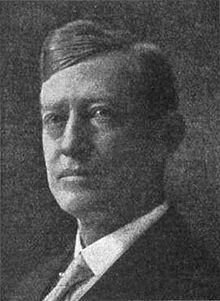- Malcolm R. Patterson
-
Malcolm Rice Patterson (June 7, 1861–March 8, 1935) was the governor of the U.S. state of Tennessee from 1907 to 1911.
Biography
A native of Somerville, Alabama, Patterson was a son of Colonel Josiah Patterson, a distinguished Confederate cavalry officer and a United States Representative for Tennessee, and his wife Josephine (Rice) Patterson.
Malcom Patterson graduated from the Christian Brothers College (now Christian Brothers University) and took literature courses at Vanderbilt University. He then studied law and was admitted to the bar in 1883. Patterson was served as attorney general for Shelby County from 1894 to 1900, then elected to the Congress. He served his father's old district, the former Tenth District, from 1901 - 1907, when he became the Democratic nominee for governor in 1906. Patterson won the election against Republican nominee H. Clay Evans of Chattanooga and was inaugurated in January 1907. He was the first governor to come from West Tennessee.[1]
During his first term, Governor Patterson married Mary Russell Gardner of Union City. He was the second Tennessee governor to marry while in office.
In October 1908, Patterson used the State Guard to suppress a "Night Rider" vigilante movement that had arisen over disputed fishing rights in Reelfoot Lake in West Tennessee. Six of the "Night Riders" were tried and condemned to be hanged for murder, with two more sentenced to twenty years in prison. Patterson was widely praised for his swift and decisive action, which brought a speedy end to the violence.
In November 1908, Patterson was renominated and defeated Republican George N. Tillman of Nashville in the election. He began his second term as governor in January 1909.
During his second term, Patterson vetoed the return of statewide Prohibition, arguing the issue should be decided at the local level rather than by the state. In a rare instance for the era, his veto was overridden by the state legislature. However, the highlight of his second term was the passage of the Tennessee General Education Act.
Patterson initially intended to seek a third term in 1910, but there was so much political turmoil, particularly within the Democratic Party over Prohibition, that he withdrew from the campaign after having already received the nomination. He was replaced as a candidate by United States Senator Robert Love Taylor, who was defeated in the general election.
Ironically, Patterson would later change his position, becoming an outspoken proponent of state Prohibition. He resumed his law practice and for the last eleven years of his life served as a Circuit Court judge.
He died in 1935 while on a visit to Sarasota, Florida. Survived by his wife and three children, he was buried in Forest Hill Cemetery in Memphis.[2]
References
- ^ http://www.tn.gov/tsla/history/manuscripts/findingaids/67-114.pdf
- ^ http://www.tn.gov/tsla/history/manuscripts/findingaids/67-114.pdf
Political offices Preceded by
John I. CoxGovernor of Tennessee
1907—1911Succeeded by
Ben W. HooperGovernors of Tennessee  Sevier · Roane · Sevier · Blount · McMinn · Carroll · Houston · Hall · Carroll · Cannon · Polk · Jones · A. Brown · N. Brown · Trousdale · Campbell · Johnson · Harris · Johnson · East · Brownlow · Senter · J. Brown · Porter · Marks · Hawkins · Bate · R. Taylor · Buchanan · Turney · R. Taylor · McMillin · Frazier · Cox · Patterson · Hooper · Rye · Roberts · A. Taylor · Peay · Horton · McAlister · Browning · Cooper · McCord · Browning · Clement · Ellington · Clement · Ellington · Dunn · Blanton · Alexander · McWherter · Sundquist · Bredesen · Haslam
Sevier · Roane · Sevier · Blount · McMinn · Carroll · Houston · Hall · Carroll · Cannon · Polk · Jones · A. Brown · N. Brown · Trousdale · Campbell · Johnson · Harris · Johnson · East · Brownlow · Senter · J. Brown · Porter · Marks · Hawkins · Bate · R. Taylor · Buchanan · Turney · R. Taylor · McMillin · Frazier · Cox · Patterson · Hooper · Rye · Roberts · A. Taylor · Peay · Horton · McAlister · Browning · Cooper · McCord · Browning · Clement · Ellington · Clement · Ellington · Dunn · Blanton · Alexander · McWherter · Sundquist · Bredesen · Haslam Categories:
Categories:- 1861 births
- 1935 deaths
- Governors of Tennessee
- Members of the United States House of Representatives from Tennessee
- Tennessee Democrats
Wikimedia Foundation. 2010.

